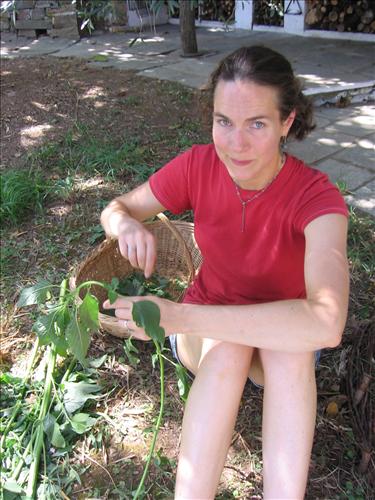
I once read that the grand party season in Old New Orleans began with Epiphany (January 6th, a.k.a. Three Kings' Day) and ended with Mardi Gras. This makes sense to me. Coming from colder, darker northern climes, I have never had much use for winter after New Years is over. The idea that somebody'd hold a big party once every weekend until Lent (and Spring!) started, well...that sounds just downright civilized. But how to determine who'd hold all those parties? In New Orleans, it's the king cake. In ring form and decorated with purple, green and gold sprinkles, it hides inside a token, be it a plastic baby Jesus figurine, coin, bean or walnut (I prefer the pleasantly edible walnut). Whoever gets the piece of cake with the token holds next week's party. Clearly Mardi Gras brings all the revelry to an end at least for 40 days. This recipe turned out waaaay better than
last year's king cake (I think I didn't even give you the bad recipe I'd followed). So this one's a keeper.
Here's the recipe:
1 cake of fresh yeast or 1 package of dry yeast
1/3 cup sugar
1/2 stick of butter
3 large eggs
1/2 cup warm milk (warmed not over 110F)
2-3 cups of all-purpose flour
1 tsp salt
2 tsps of sweet spice. I used 1 tsp nutmeg and 1 tsp cardamom, but you can also try allspice, cinnamon or ground ginger
1 tsp grates citrus zest. I used orange zest but any other citrus fruit would work nicely
vegetable oil
4 ozs (120 grams) cream cheese
1-1/2 cups powdered sugar
1-3 tablespoons milk
purple, green and gold sugar for sprinkling
one walnut half
First mix the yeast cake with the sugar, butter, eggs and milk breaking it up and allowing it to get foamy. Let the mixture settle for about 5 minutes then add the spices, zest, salt and 2 cups of the flour and mix thoroughly. If the dough looks too impossibly gloopy to knead, add up to one more cup trying to use as little flour as possible. The less you add the springier the cake will be. Pour a few drops of vegetable oil on the dough and rub it all around to cover. Return to the bowl and cover with a damp towel. Allow to rise for about 2 hours or until doubled in bulk.
While the dough is rising, make the cream cheese filling. In a medium mixing bowl, add the cream cheese and blend in 1/2 cup of the powdered sugar. Mix until the texture is smooth. Refrigerate until needed.
Once the dough is risen, punch it down and place on a cool, smooth surface. **Even though it takes more time, I like to chill my dough before shaping it. This is a brioche-style dough and thus very loose and sticky. Chilling it helps to make it easier to handle. This allows you to shape the dough using as little extra flour as possible. Roll the dough out to 2 to 2-1/2 feet long and 6 inches wide.
Music to roll king cake dough by: "The King Porter Stomp" by Jelly Roll Morton. Spoon the cream cheese filling along the center of the dough strip and fold one side over. Now's the time to hide the walnut, baby Jesus, bean or coin in the cake. Just place it somewhere along the filling and close up the dough. Pinch the seam of the dough and bring the ends around to touch making a ring. Place the dough on a greased pizza pan or cookie sheet with a greased, empty can in the center to hold the ring shape. Place in a very large plastic bag to rise again for about 1 hour. Pre heat the oven to 350F.
Bake for 30 minutes or until uniformly golden brown. Remove from oven and let cool completely before decorating. Rub the whole surface of the cake with a little melted butter on your impeccably clean fingers. Begin to sift the different colors of sugar to make stripes of purple, green and gold. Then mix the remaining cup of powdered sugar with 1 tablespoon of milk. If the consistency is solid, att more milk by drops until you achieve a putty-like consistency. The frosting should be only just liquidy enough to pour. If it is too liquidy, it will drip right off the cake into puddles on the plate. Serve with a flourish and an eye toward the next party!
 French food is so perfect for a chilly evening. It's often very substantial with lots of cream and butter. Well the traditional French cuisine is, not the 3 peeled baby carrots served with a raspberry coulis or somesuch of Nouvelle Cuisine fame. This lapin à la crème is from the annals of classic French cooking and it'll keep you warm, fortify you and stick to your ribs (thighs, butt, etc.).
French food is so perfect for a chilly evening. It's often very substantial with lots of cream and butter. Well the traditional French cuisine is, not the 3 peeled baby carrots served with a raspberry coulis or somesuch of Nouvelle Cuisine fame. This lapin à la crème is from the annals of classic French cooking and it'll keep you warm, fortify you and stick to your ribs (thighs, butt, etc.).






